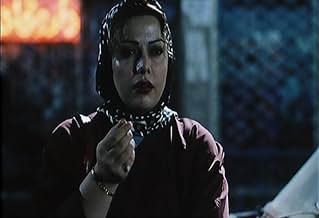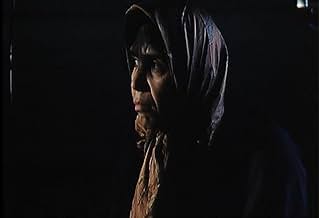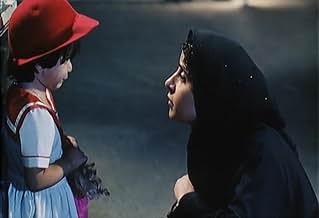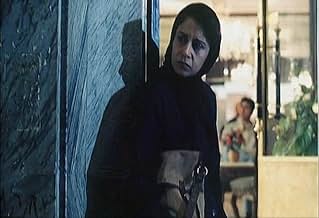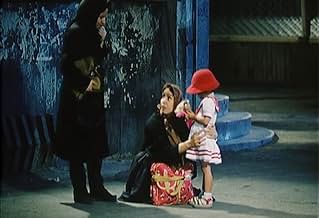IMDb RATING
7.4/10
7K
YOUR RATING
Various women struggle to function in the oppressively sexist society of contemporary Iran.Various women struggle to function in the oppressively sexist society of contemporary Iran.Various women struggle to function in the oppressively sexist society of contemporary Iran.
- Director
- Writers
- Stars
- Awards
- 12 wins & 7 nominations total
Maryiam Palvin Almani
- Maryam Parvin Almani (Arezou)
- (as Maryam Parvin Almani)
Fereshteh Sadre Orafaiy
- Fereshteh (Pari)
- (as Fereshteh Sadr Orafai)
- Director
- Writers
- All cast & crew
- Production, box office & more at IMDbPro
Featured reviews
A baby girl is born, and the grandmother regrets for the sex of the baby. Three women are released under probation from the jail and get lost into the crowd, without courage to come back home and having no money. A woman escape from the jail to make an abort and is expelled from her own home by her family. Another woman left her daughter of about six years old alone on the street. A prostitute is arrested with her client in his car, and the man is released by the police later while the woman goes to jail. All of these individuals and disconnected situations are presented to show the repressive situation against the women in the Iranian society. In the end, like in a circle, all of them ends arrested in the jail. I am not aware of the behavior of the Iranian society with their women, but this movie portraits a horrible picture. The women are showed without freedom, depending on her husband or her family even for simple actions, like traveling in a bus. If their society works this way, how are these actresses daily treated after their performances in this movie? The camera and the direction are excellent. It is amazing the capability of the Iranian filmmakers in making simple but touching films. My vote is eight.
Title (Brazil): `O Círculo' (`The Circle')
Title (Brazil): `O Círculo' (`The Circle')
While Jafar Panahi's previous feature films dealt with children, with Dayereh he delves into the contentious issue of women's issues in a highly restrictive society, his native Iran. The film uses a narrative device that Tarantino might be proud to steal, with Panahi's camera following various women through their specific plights, often chasing them through the streets in handheld mode. At any moment, the camera may decide to follow a different character, and although the specific details of the various women's situations may differ, the oppression which is a part of their daily lives is consistently omnipresent. One feature of the film that is part and parcel of its roving camera approach is that there is very little in the way of exposition or denouement in any of the narrative threads. This however, seems to be the point of the entire exercise; in a society that treats women as a lower class of citizen, individual details and circumstances have no bearing on their ability to achieve anything without the presence or authority of a husband or father.
veryday occurrences such as the purchase of a bus ticket to the simple act of smoking a cigarette in public can (and does) result in mandatory incarceration for any woman at any time. The structure of the film gives the impression that literally any woman you might bump into on the streets of Tehran is caught in such a comprehensively prohibitive society that could lead to what could only be considered unconscionable drama in Western society.
Although there are no significant male characters in this story, Panahi uses the entire gender en masse to illustrate the peculiar double standards that have insinuated itself through the fabric of this society. Men are constantly harassing women with inappropriate lewd remarks to which there can obviously be no response to. Simultaneously, if a woman behaves in a manner anything less than perfectly virtuous, her liberty is instantly forfeit.
In one scene, a woman starts to stand up for herself against a casually tossed piece of innuendo, and the audience can do nothing except anticipate the unjust retaliation that will surely be endorsed by the dozens of common passers-by. There are certain elements of the film that no doubt owe to the nature of making a film under these conditions; extras occasionally can't avoid staring at the camera crew, but strangely enough, this gives the film a feel of documentary film-making that somehow enhances the narrative. Nevertheless, there is nothing amateurish about the acting of the principal women, all of whom behave so convincingly that the film conveys a sense of constant danger. Furthermore, this nervous energy never lets up, as we move from story to story at a speed that allows us to experience discomfort, without reaching closure until the final scene, which in itself is a cause for distress.
It is unlikely that Dayereh will ever be a very popular film, as it has many of the 'feel-bad' qualities of films such as A Time For Drunken Horses, with even less sympathetic sentimentality. On an even sadder note, Dayereh has been banned in Iran, where a film of this nature most desperately needs to reach an audience. However, this seems to be the underlying message of the film; not that there are a great many injustices against women occurring in Iran on a daily basis, but that there is no indication of how or when it will stop. Only why.
veryday occurrences such as the purchase of a bus ticket to the simple act of smoking a cigarette in public can (and does) result in mandatory incarceration for any woman at any time. The structure of the film gives the impression that literally any woman you might bump into on the streets of Tehran is caught in such a comprehensively prohibitive society that could lead to what could only be considered unconscionable drama in Western society.
Although there are no significant male characters in this story, Panahi uses the entire gender en masse to illustrate the peculiar double standards that have insinuated itself through the fabric of this society. Men are constantly harassing women with inappropriate lewd remarks to which there can obviously be no response to. Simultaneously, if a woman behaves in a manner anything less than perfectly virtuous, her liberty is instantly forfeit.
In one scene, a woman starts to stand up for herself against a casually tossed piece of innuendo, and the audience can do nothing except anticipate the unjust retaliation that will surely be endorsed by the dozens of common passers-by. There are certain elements of the film that no doubt owe to the nature of making a film under these conditions; extras occasionally can't avoid staring at the camera crew, but strangely enough, this gives the film a feel of documentary film-making that somehow enhances the narrative. Nevertheless, there is nothing amateurish about the acting of the principal women, all of whom behave so convincingly that the film conveys a sense of constant danger. Furthermore, this nervous energy never lets up, as we move from story to story at a speed that allows us to experience discomfort, without reaching closure until the final scene, which in itself is a cause for distress.
It is unlikely that Dayereh will ever be a very popular film, as it has many of the 'feel-bad' qualities of films such as A Time For Drunken Horses, with even less sympathetic sentimentality. On an even sadder note, Dayereh has been banned in Iran, where a film of this nature most desperately needs to reach an audience. However, this seems to be the underlying message of the film; not that there are a great many injustices against women occurring in Iran on a daily basis, but that there is no indication of how or when it will stop. Only why.
In Jafar Panahi's claustral feature debut, the brilliant central conceit is that being a woman in Iran is exactly equivalent to being the Wrong Man in an Alfred Hitchcock movie. In the movie's nameless Iranian city, the narrative baton is handed off from one woman to another, each of them missing an ID card, a chaperoning male, some form of social validation; without it, the long arm of the law winds around each woman like a python. Panahi's style--long, fluid takes that are at once bruisingly verite and dreamlike--buckles in the script's ingenious (and perhaps unconscious) major device: in this movie, women are a secret underworld with nodding, unspoken signals, just like hoodlums silently acknowledging one another in a gangster picture. There is no warm-hug sisterhood here, just the desperate mutual regard of the about-to-be-caught.
The honesty and unfussiness of the style of contemporary Iranian directors enables them to get away with stuff other artists might not, such as the ending of this movie, which, in a European or American movie, might seem thuddingly unsubtle. Here, it seems like the fulfillment of a nightmare--and it works because of Panahi's wittily blunt style, which is pitched somewhere between Iranian neorealism and Elaine May's MIKEY AND NICKY. And it works because of our constant recognition of the literal, physical courage of the movie: our glimpses of current state attitudes toward abortion, prostitution and corrupt police are so bald one marvels at Panahi's (and the cast and crew's) effrontery. Never has chador seemed less exotic and more evil--a manifestation of a terror of the beauty and pleasure of the female body that seems to engulf each character like a Cronenbergian plague. (The movie's wittiest touch is Cronenbergian, too: a woman character has a tic that gives her away to the cops--pregnancy-induced vomiting.)
The honesty and unfussiness of the style of contemporary Iranian directors enables them to get away with stuff other artists might not, such as the ending of this movie, which, in a European or American movie, might seem thuddingly unsubtle. Here, it seems like the fulfillment of a nightmare--and it works because of Panahi's wittily blunt style, which is pitched somewhere between Iranian neorealism and Elaine May's MIKEY AND NICKY. And it works because of our constant recognition of the literal, physical courage of the movie: our glimpses of current state attitudes toward abortion, prostitution and corrupt police are so bald one marvels at Panahi's (and the cast and crew's) effrontery. Never has chador seemed less exotic and more evil--a manifestation of a terror of the beauty and pleasure of the female body that seems to engulf each character like a Cronenbergian plague. (The movie's wittiest touch is Cronenbergian, too: a woman character has a tic that gives her away to the cops--pregnancy-induced vomiting.)
I have seen several Iranian films in the past few weeks thanks to a short season of the films screened in the UK by Channel 4 a channel that can rise above the level of reality television when it puts its mind to it. Having seen them in a compact space of time, I had quickly gotten it in my head that many of those screened had come to international attention and various degrees of acclaim because they were "issue" films that looked at some aspect of Iranian life with at least a semi-critical eye. However none of them came close to the sort of anger with the system that was evident throughout this film.
The plot sees several stories that weave around one another to produce a film that looks at several women, all of whom are suffering in some way or other due to the general treatment of women in Iran. As a dramatic device it doesn't totally work because too little time is spent with each character to really get to know them or get into their stories and situations, but this struck me as being the film's second aim with the first quite clearly being the injustice with which women are treated. As such, the narrative never really engaged me in terms of the people in the story, but the general picture painted was interesting enough to hold my attention and make me care for the characters generally, even if I would struggle to put names to faces.
The actresses are all pretty good and most come off pretty natural and convincing, with only the odd moment here and there not really working. They all strike a rather tragic note with each of them trying to make out the best they can in life but really oppressed in so many ways whether it is small things like not easily moving in the streets by themselves or being rejected by their families to save honour. The direction is good, with different styles used for some of the characters but done in a subtle way to the point where I didn't notice until somebody pointed it out to me.
Overall this is a good film but not a brilliant one mainly because the narrative comes secondary to the criticism of the system. However it is worth seeing mainly because, without really ranting, it holds a lot of anger at the status of Iranian women and their treatment and the injustice within the system it may not be balanced but it is interesting and engaging.
The plot sees several stories that weave around one another to produce a film that looks at several women, all of whom are suffering in some way or other due to the general treatment of women in Iran. As a dramatic device it doesn't totally work because too little time is spent with each character to really get to know them or get into their stories and situations, but this struck me as being the film's second aim with the first quite clearly being the injustice with which women are treated. As such, the narrative never really engaged me in terms of the people in the story, but the general picture painted was interesting enough to hold my attention and make me care for the characters generally, even if I would struggle to put names to faces.
The actresses are all pretty good and most come off pretty natural and convincing, with only the odd moment here and there not really working. They all strike a rather tragic note with each of them trying to make out the best they can in life but really oppressed in so many ways whether it is small things like not easily moving in the streets by themselves or being rejected by their families to save honour. The direction is good, with different styles used for some of the characters but done in a subtle way to the point where I didn't notice until somebody pointed it out to me.
Overall this is a good film but not a brilliant one mainly because the narrative comes secondary to the criticism of the system. However it is worth seeing mainly because, without really ranting, it holds a lot of anger at the status of Iranian women and their treatment and the injustice within the system it may not be balanced but it is interesting and engaging.
Devastating film that details the harsh treatment of women in Iran. The film begins with a hospital scene, where a family take the news of a new baby girl in the family so harshly that one would think the child had been stillborn. Following that the story introduces us to a group of women, one after the other, each of them recent convicts (in Iran a woman is put in jail indefinitely for riding in a car with a man she is not related to) who have their own struggles to overcome before they can seek asylum from the clausterphobic society that surrounds them. The film isn't as satisfying as it should be (even given its subject matter), and definitely deserves to be more engrossing. It is, however, an important human rights issue worth examining and for all it shows of a world as different from our North American society, it deserves a good look from us all.
Did you know
- TriviaPanahi adopted a different camera style to depict each of the four main protagonists' lives. For the first, an idealistic woman he used a handheld camera. For the second woman, the camera is mounted on a constantly moving dolly. The third woman's story is told at night in darker outside, and the camera is static with pans and tight close ups. For the last, least optimistic woman both the camera and the woman are completely immobile and very little sound is used.
- ConnectionsFeatured in Cinema Iran (2005)
- How long is The Circle?Powered by Alexa
Details
Box office
- Budget
- $10,000 (estimated)
- Gross US & Canada
- $440,554
- Gross worldwide
- $756,035
Contribute to this page
Suggest an edit or add missing content


